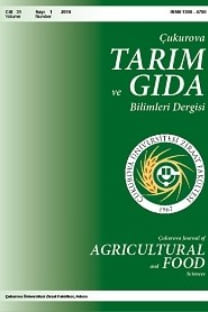Ekmeklik Buğdaya Yapraktan Farklı Doz ve Zamanlarda Uygulanan Çinko ve Azotun Tanenin Besin Elementi İçeriğine Etkisi
Bu araştırma, ekmeklik buğdaya yapraktan farklı doz ve zamanlarda uygulanan çinko ve azotun tanenin besin elementi içeriğine etkisinin belirlenmesi amacıyla yürütülmüştür. Bu amaçla planlanan denemeler, tarla koşullarında iki farklı lokasyonda, tesadüf blokları bölünen bölünmüş parseller deneme deseninde 4 tekerrürlü olarak yürütülmüştür. Ekmeklik buğdaya, çiçeklenme öncesi (kardeşlenme ve sapa kalkma) ve çiçeklenme sonrası (erken süt olum dönemi ve erken hamurlaşma dönemleri) dönemlerde yapraktan azot ve çinko uygulamaları yapılmıştır. Yapraktan azot uygulamalarında % 0 (-üre) ve % 0.5’lik (+ üre) üre dozları kullanılmıştır. Yapraktan Zn uygulamalarında ise % 0, % 0.1, % 0.3 ve % 0.5’lik ZnSO4 solüsyonu kullanılmıştır. Yapraktan çinko ve azot uygulamalarının Adana-99 ekmeklik buğday çeşidinin tane azot (%), çinko, demir konsantrasyonu (mg kg-1), verim (kg/da) ve 1000 tane ağırlığı (gr) değerleri üzerine etkisi araştırılmıştır.Genel olarak, yapraktan Zn uygulamalarının tane N konsantrasyonu üzerine etkisi Hacıali lokasyonunda istatistiki olarak önemli bulunmazken, Doğankent lokasyonunda ise önemli bulunmuştur. Hem Hacıali hemde Doğankent lokasyonunda, yapraktan Zn uygulamalarının tane Zn konsantrasyonu üzerine etkisi istatistiki olarak önemli bulunmuştur. Yapraktan Üreli ve Üresiz koşullarda Zn dozları açısından bakıldığında her iki üre uygulamasında da en yüksek Zn konsantrasyonu %0.5 ZnSO4 uygulamasından elde edilmiştir. Her iki lokasyonda yapraktan Zn uygulamaları tane Fe konsantrasyonu üzerinde olumlu etki yapmıştır. Buğdaya çiçeklenme sonrası (ÇS) dönemde yapılan uygulamalar tane Zn konsantrasyonu üzerinde daha etkili olmuştur.
Effects Of Different Foliar Zinc And Nitrogen Doses And Treatment Periods On Kernel Nutrient Contents Of Bread Wheat
This research was carried out to determine the effects of different doses and application times of zinc and nitrogen on bread wheat. The experiments were carried out in field conditions at two different locations, with 4 replications in divided splits parcel design in random blocks. Foliar nitrogen and zinc were applied to wheat at pre-anthesis (tillering and bolting) and post-anthesis (early milk stage and early dough stage) periods. 0 % (- urea) and 0.5 % (+ urea) doses were used for foliar nitrogen applications. 0 %, 0.1 %, 0.3 % and 0.5 % ZnSO4 solution were used for Zn applications. The effects of foliar nitrogen and zinc treatments on grain nitrogen (%), zinc and iron concentrations (mg kg-1), yield (kg da-1) and 1000-grain weight of Adana-99 bread wheat cultivar were investigated.In general, the effect of Zn application on the grain N concentration was statistically insignificant in Hacıali location, whereas it was found significant in Doğankent location. In both Hacıali and Doğankent locations, the effect of Zn application on grain Zn concentration was statistically significant. The highest Zn concentration in both urea (+ urea and - urea) applications was obtained from 0.5 % ZnSO4 application. In both location, Zn application to soil has a positive effect on Fe concentrations. Post-anthesis applications were more effective on grain Zn concentrations.
___
- Cakmak, I., Pfeiffer, W.H., Mcclafferty, B. (2010a). Biofortification of durum wheat with zinc and iron. Cereal Chemistry 87(1), 10-20.
Kutman, U. B., (2010a). Roles of nitrogen and zinc nutrient in biofortification of wheat grain. Sabanci Üniversity. PhD Thesis.
Kutman, U. B., Yildiz, B., Ozturk, L., Cakmak, I. (2010b). Biofortification of durum wheat with zinc through soil and foliar applications of nitrogen. Cereal Chem. 87: 1-9
Kutman, U. B., Yildiz, B., Cakmak, I. (2011a). Effect of nitrogen on uptake, remobilization and partitioning of zinc and iron throughout the development of durum wheat. Plant Soil. 342: 149-164.
Kutman, U. B., Yildiz, B., Cakmak, I. (2011b). İmproved nitrogen status enhances zinc and iron concentrations both in the whole grain and the endosperm fraction of wheat. Journal of Cereal Science. 53: 118-125.
